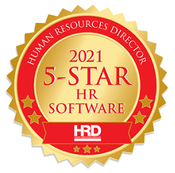Using a human centric system to keep employees connected, positive, and engaged explained.The global pandemic has thrown the world a curve ball and businesses have had to shift focus to find new ways of engaging, attracting, and retaining the best people. Cloud systems have gone a long way to alleviate the administrative burden of HR however until now, they have fallen short at actually providing a system to drive the human experience of work – This was our desire when designing The H Factor.  In the 2021 HR Software awards, Human Resources Director (HRD) magazine awarded The H Factor (“THF”) their 5-Star HR Software Award; recognising us and nine others, as “best for quality and range of solutions, specialist expertise, and client service”. We sincerely thank them for this acknowledgement and want to provide some assistance to help business leaders build a better future for themselves and their people. In this guide, you'll learn:
How can technology assist us to focus on transformation rather than mere survival?We have wonderful business technology however the human experience was being left behind. The human experience cannot be underestimated or ignored; we should be talking transformation rather than just recovery when it comes to the global pandemic of COVID-19! We need to go back to the basics of the why/purpose of the organisation. But we need to do a lot more than just playing around the edges and using language like ‘soft skills’; they are not, they are human skills! Too many employees worldwide are disengaged, we’re working longer hours, and trying to cope with both financial and mental stress. We believe that a system should assist in developing leaders differently; allowing them to reinvent themselves around a human focus. We need to change the way businesses lead their people without the need for face to face interactions. The days are gone when we valued simply turning up to work. We need to value, and focus on the quality of outcome delivery. And we need to handover ownership to those tasked with delivering these outcomes, through simply posing the question “if this is the outcomes you are responsible for, how is it you’d like to deliver them, and what is it I (as the leader) can do to assist you in that?” Human beings have an aversion to being told what to do. With this fact in mind, a system needs to give real autonomy and encourage ownership thinking through developing clear outcomes and self-developed KPIs; the result of which is motivated, more engaged employees, and leaders who begin to genuinely feel comfortable to let go the reins a little, and not micromanage. Most systems manage employee data. We’ve seen employers spending thousands on collecting data without a clear understanding of how to use that data to positively affect performance behaviours. A system driven human experience needs to do much more than self-managed leave approval, time sheets, or number rated performance reviews. It should be about encouraging bottom up engagement that allows your people to strategically build how they want to best deliver their outcomes and how their success could be measured. Were most systems are about process automation to drive efficiency and compliance that allows managers to then focus on the people, we wanted to assist users to focus on the people aspects first, and make the processes and compliance a non-issue. The system comes complete with inbuilt compliance policies around fair work and the NES, along with a platform for users themselves to capture their work and operational processes as text, video, or pictures, to build your very own business ‘Wiki’. There’s easy access to capturing employee led innovation; a platform for peer to peer recognition; a new approach to recruitment that does away completely with the outdated CV and replaces it with an invitation to directly address the delivery of desired outcomes; and much, much more. How do we maintain, or even improve on our business culture and values?Being able to articulate your culture and the behaviours that drive it is of paramount importance to building a community that people want to be a part of and contribute to. Taking on Simon Sinek’s philosophy of starting with why, goes a long way to delivering this. While implementing THF you’re guided to effectively articulate the reason your business exists. We like to practice what we preach and for us: We believe that everyone has the right to create the extraordinary. Our system brings people together to enable them to share the joy of contribution, achievement, and fulfilment. Your values - or perhaps better; your not negotiable rules of engagement - are what guide the behaviours of the people in your organisation. As such individual words like; honest, integrity, or teamwork, just won’t cut it! These provide no guidance at all; they’re just single words, and without context mean absolutely nothing. With THF you’ll discover what value statements will be most effective to drive the desired behaviours of the organisation. In order to effectively drive behaviours, your value statements should start with a verb, eg:
Value statements such as these, create clarity, give permission, and provide a base line for discussions around performance. When your employees log on, the landing page is where they’ll find the “Business Story” expressing your business’s why, your brand values, your high level strategic intent, and your value statements; all designed to ensure that they remain relevant and top of mind. How do we improve performance and productivity?We know that most people do not look forward to the old fashioned performance appraisal process. Particularly those that ask you to rate yourself from 1-5 in a variety of competencies and then your supervisor will do the same and then you’ll get together to discuss your performance. But what actually happens is, you get together to debate the difference between a 2 and a 3! That’s not only uncomfortable, and sometimes even upsetting, but also a complete waste of time. It's well known that the old system has failed ... but what do we replace it with? THF system was based on the science of performance, engagement, and the positive benefits of collaboration, ownership, and achievement. The best way to improve performance is to shift the focus of performance conversations/reviews from talking to someone about them (the reason they’re uncomfortable), to talking about the outcome they’re responsible for delivering and asking them how they would like to deliver it. Your job as leader is to simply guide the conversation through questioning, and clear the barriers to them delivering effective performance. In effect it’s the difference between assessment and engagement. We wanted to build a system that was not about assessing performance of an individual. Instead we wanted it to engage them in the ownership of their own outcomes and deliverables, understand how what they do contributes to the bigger picture, and where deliberate poor performance could not be accommodated. We also wanted to add self-driven KPIs that were strategically created, discussed, and negotiated, to ensure they would be an accurate indication of the success of the activity that was going to deliver the outcome/s. There is a realisation though COVID that business cannot rely on attracting skills from outside. The skills shortage is impacting heavily and business needs to adapt quickly to build capacity and skills from within to grow. Therefore effective conversations about outcomes and a tool to build a skills matrix is imperative. ConclusionIt’s human nature to seek; purpose, community, autonomy, and fulfilment. When you understand this and develop processes and systems that instil this within your organisation, you’ve already gone a long way to developing a positive employer brand through being a great place to work. There’s no going back to the old ways of working … and that’s a good thing. Although we’re operating in challenging times, the end result, we believe, will be a positive shift in our approach to “Business for Humans”. The challenge that COVID has thrown at us is that we have to create organisations where people can:
If you’d like to learn more about The H Factor’s approach to providing this, we’d love to show you.
0 Comments
|
AuthorsH Agents write about the joys and challenges of entrepreneurship and managing people. Archives
May 2024
|
(c) Copyright 2024 INCOMMAND Pty Ltd. View our privacy policy and data security statement. Please note that your use of The H Factor system is subject to our Terms of Service.


 RSS Feed
RSS Feed